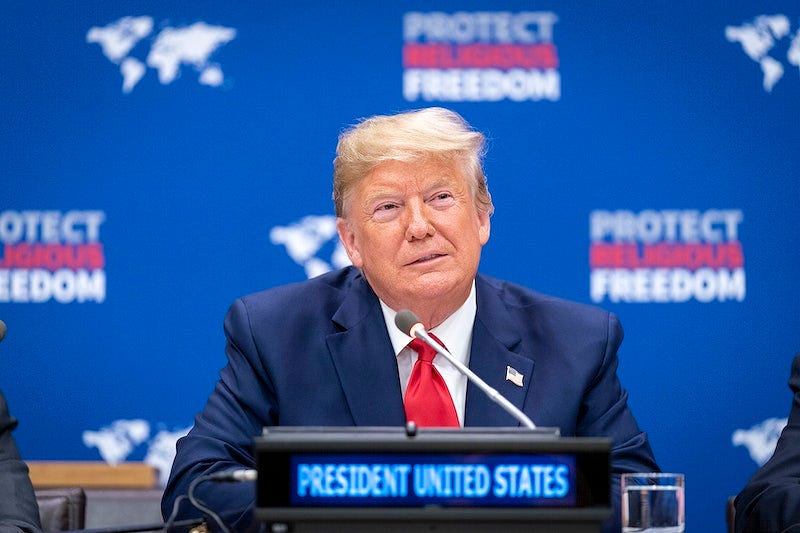The political parties in the United States are incredibly different from each other. I think we all know that. There are many vectors to explain this divergence. Certainly race plays a role. Republicans are a whole lot more white than Democrats. There’s the geographic divide. The GOP is a party of rural America, and the Democrats tend to do much better in densely populated urban cores. You get the picture.
But, of course, the parties are also incredibly divided in the area of religion. We’ve got a term for it: the God Gap. Simply put, religion in the United States (particularly white religion) is now Republican-coded. The Democrats, on the other hand, are the party of the “nones”—those with no religion. At least, that’s what we think we know. That’s how it seems always to have been. But is that for real? Well, we just had an election, and I’ve got new data. So let me show you how the religious composition of Trump’s voters diverged from those who cast a ballot for Kamala Harris.
Let’s start using a religious behavior metric—attendance at houses of worship. This is the breakdown in each of the last five presidential elections among voters who cast a ballot for the Republican candidate.
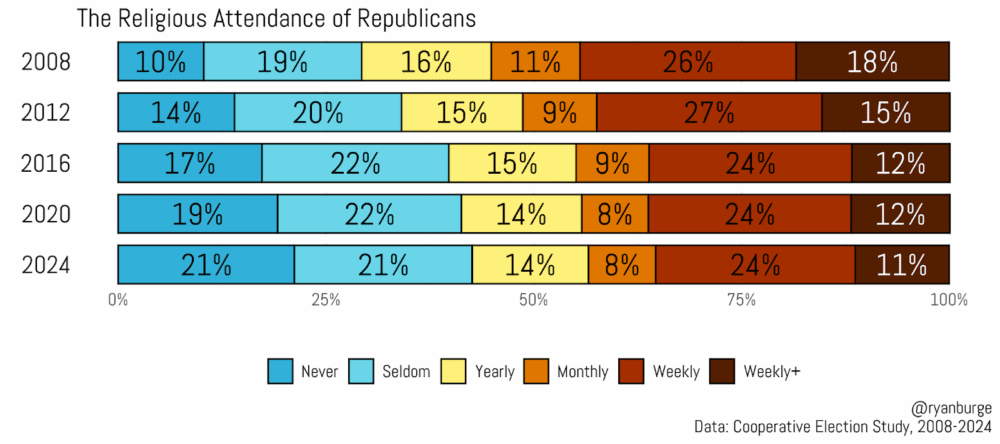
The GOP was highly religiously engaged back in the Barack Obama vs. John McCain matchup, in 2008. About 44 percent of McCain’s voters reported attending a house of worship every week. In comparison, only 29 percent said that they attended church less than once a year. But that low-attending share has risen significantly in subsequent elections. In the last two cycles, the share of Republican voters who attend church never or seldom has risen to 42 percent. That’s due, almost entirely, to the rise of the never-attending Republicans. They were only 10 percent of voters in 2008, and now they’re around 20 percent. That’s a pretty good data nugget—Republicans today are twice as likely to never attend a house of worship as they were in 2008.
And you can probably guess that attendance at the top end has also dipped. Weekly attendance dropped to 42 percent by 2012, and lost another 6 points by 2016. But what’s really striking to me is that this share hasn’t budged during Trump’s three runs for the White House—it’s been stuck at about 35 percent. The other thing worth noting is that the share of Republican voters who attend weekly hasn’t really changed much; it’s the more-than-once-a-week people who have started to disappear.
What about Democrats?
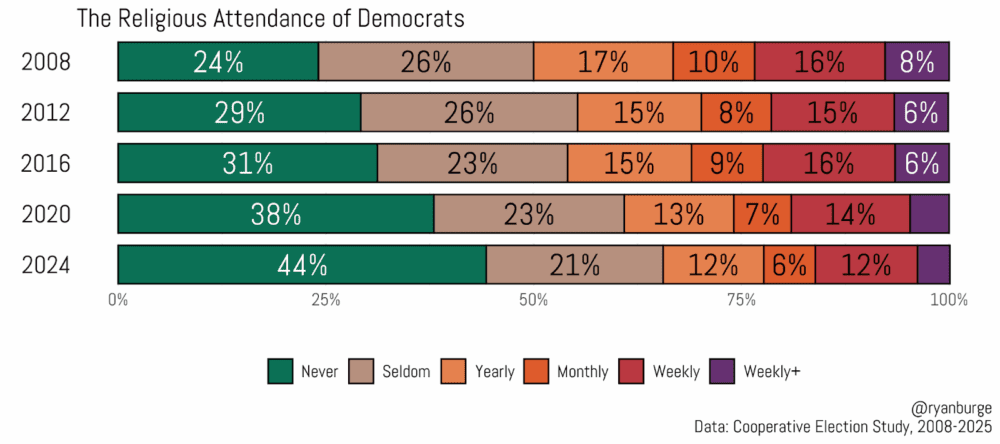
In 2008, half of Democratic voters were attending never or seldom, and just a quarter were weekly attenders. But those low attendees have really skyrocketed in the last couple of cycles. They accounted for more than 60 percent in 2020—and then look at those 2024 numbers! About two thirds of voters for Kamala Harris were attending a house of worship seldom or never. Among Trump voters, that figure was 42 percent.
And you can probably guess that there aren’t a lot of weekly attenders left on the Democrats’ side, either. In 2024, just 17 percent of Democratic presidential voters were weekly attenders. Let me put it to you this way: for every Harris voter who attended church weekly in 2024, there were about four Harris voters who attended less than once a year. If that’s not the God Gap, I don’t know what is.
But let’s also do this based on religious affiliation. If you want to see what the Trump coalition looked like in 2024, this is it. I also threw in this same analysis for when McCain was on the ballot, to get a sense of how things have shifted. In the graph below, the red represents 2024, and the blue 2008.
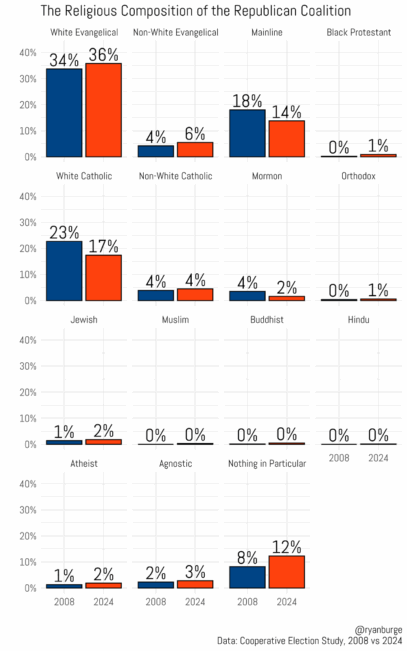
Here’s the huge headline for me: evangelicals are incredibly important to the GOP on Election Day. It’s hard to overstate this fact. In 2008, 38 percent of all McCain’s voters were evangelical. When Trump won in 2024, 42 percent of his ballots came from evangelicals. There is no more important voting bloc in the country than evangelicals if you are Republican. It’s basically impossible to win any race without their support. But other Christian groups are less important in recent years. The mainline share is down 4 points since 2008, and the white Catholic voters were six points fewer in 2024 than they were in 2008.
The only other group that really registers much at all are the “nothing in particular” people. They were 8 percent of McCain’s votes, and Trump drove that up to 12 percent. But note that atheists/agnostics account for just 5 percent of all the GOP votes now, up two points since 2008. But that’s really the whole ball of wax.
So let me make this exceedingly clear: the GOP is a party of Christians. About 80 percent of all Trump’s votes came from Christians. To be even more specific, 70 percent came from white Christians. The GOP is the party of white Christianity.
What about the Democrats? Well, they certainly aren’t running up the score with Catholics and Protestants. Again, red is 2024, blue is 2008.
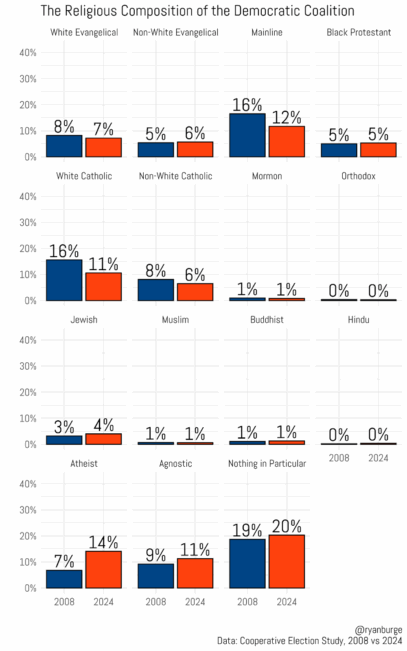
I am pretty struck by how much stability I see across the top couple of rows, honestly. In 2008, about 13 percent of Obama’s votes came from evangelicals. It was 13 percent for Harris in 2024. Think about this simple fact for a minute—in absolute numbers, there were more evangelicals who voted for Harris than mainline Protestants. That’s just how small the mainline is now. Even if they were super liberal (and they aren’t), there just aren’t enough voters to really make a huge difference at this point. But it’s also true that the Democrats have problems with the Catholic vote—white Catholics were only 11 percent of the Harris vote.
So, how do Democrats not get blown out in every election? It’s the nones. That’s the answer. There are a lot of nones, and they lean heavily towards Democrats. I want to make this point clear—atheists and agnostics were 16 percent of the Obama coalition. Now, they are about a quarter of the Democratic party. If you throw the nothing-in-particulars in there, the nones make up 45 percent of all Democratic votes cast. That’s up 10 points since 2008.
Let me just summarise this succinctly. The GOP vote is 80 percent Christian and 17 percent non-religious. The Democratic vote is 48 percent Christian and 45 percent non-religious.
That’s the God Gap.
Let me go one layer deeper on this and show you the religious composition of both parties but break it down by voters under 35 and over 65. That will give us a sense of where the parties were a few decades ago and where they will be a few decades from now.
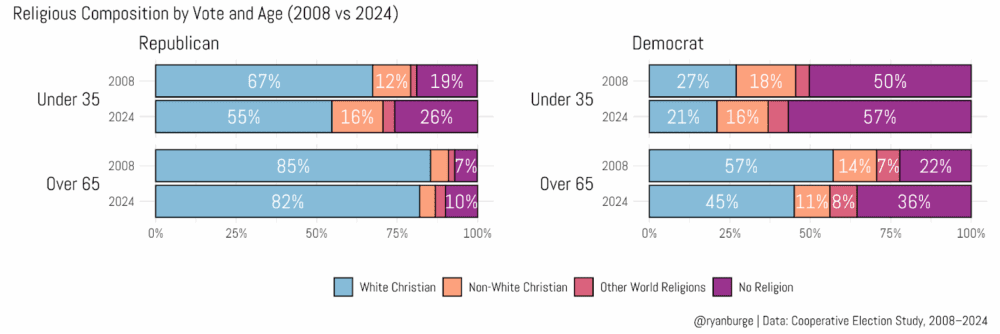
The top left are young Republicans in 2008 and 2024. Note how little the nones have risen between these two elections. They were 19 percent of McCain voters in 2008 and were 26 percent of Trump’s coalition in 2024. In other words, there’s not this huge wave of nones coming in the next generation of the GOP. Practically speaking, if I were running GOP campaigns, I wouldn’t worry about reaching out to secular voters too much. There just aren’t enough of them.
But also take note of the bottom left graph—there’s been almost no religious shifting among older Republican voters. The white Christian share is incredibly high—still 82 percent in 2024. That’s the core of the GOP in my estimation—old, white Christians. But also note that even a majority of young Trump voters were still white Christians in 2024. The GOP is the party of white Christianity.
The future of the Democratic party is decidedly not among the white Christians. Just one in five voters under the age of 35 who voted for Harris were white Christians. That’s down six points since 2008. In contrast, 57 percent of all young Harris voters were non-religious. That’s 31 points higher than the young Trump voters.
Yet, I was also struck by how much the nones had risen among older Democrats, too. In fact, it was the largest increase in any of these four graphs. In 2008, just 22 percent of Obama’s older voters were non-religious. In 2024, among voters over the age of 65 who supported Harris, 36 percent of them were non-religious. That’s ten points higher than Trump’s young voters in 2024.
I think that both parties should take heed of these results, because both the Democrats and Republicans are going to face big structural problems in the future.
For its part, the GOP needs white Christians to win elections. The share of Americans who are white is dropping. The share of Americans who are Christians is the lowest it’s ever been (but the number has plateaued). You can’t win elections with a shrinking demographic group.
And the Democrats are the party of the non-religious and the non-Christian groups. But the problem there is that the nones aren’t large enough to sway national elections right now. They might be in fifteen to twenty years, but certainly not yet. A coalition of Muslims, Black Protestants, and atheists is not easy to hold together, either.
It seems that the two parties are trying to navigate some very significant demographic shifts in the population right now. Race is changing. Religion is changing. Society is changing. But we still go to the ballot box every two years. How the parties can build slightly bigger coalitions without alienating their base will dictate how many elections they win or lose.

